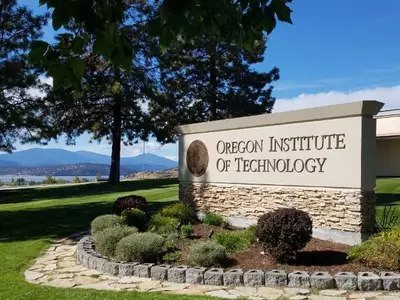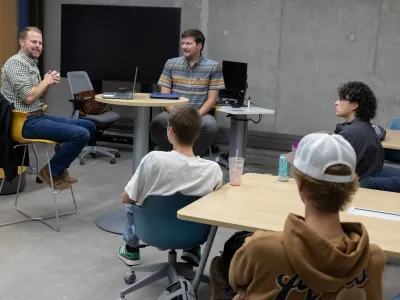As a program launched in 2015, the Population Health Management degree at Oregon Institute of Technology has graduated 25 students into successful careers in the community health field. “PHM” as it is commonly referred to on campus, goes far beyond the classroom, building relationships with local and regional organizations to put this new field into practice. Put simply, population health management is about keeping people out of the hospital- by helping people manage chronic illness, prevent disease and disability, and investing in the community conditions that support the well-being of everyone.
Located at Gaucho Collective on Klamath Falls’ Main Street, PHM has brought the classroom into the field through the Population Health Management Research Center, which serves as a training ground for PHM students. Through the Research Center students work on projects for clients- groups or organizations that require services in social research, program evaluation and community outreach activities. The center is a hub of PHM activities and was started by the first cohort of PHM students, along with Oregon Tech faculty member and PHM director, Sophie Nathenson, Ph.D.
The Research Center’s projects have been diverse- from tobacco policy and education, to emergency preparedness, renewable energy and economic development. The Research Center’s most recent projects have included:
- Assistance with Klamath County’s latest Community Food Assessment and the Community Health Assessment
- Research projects on nutrition, food waste and food security- presented at regional conferences
- Participation in a local program, “Park and Play,” which feeds children during the summer in low-income areas while also providing enrichment activities.

Students have also had the opportunity to work closely with faculty on other research projects. Kyle Chapman, Ph.D., has received funding for various research projects that include students. His students have worked on projects related to medical appointment nonattendance, head and neck cancer screenings in Klamath County, air quality and hospitalization rates, chronic illness management and prevention programs, and the effectiveness of after school programs. They have also worked with community partners like Blue Zones on the Trail Count, which collects data on the use of trails, bike lanes, and other forms of transportation to help policy makers and community organizations better understand how pedestrians and nonmotorized vehicle users are utilizing the existing transportation paths. Through these experiences, students have been able to gain real-world, applied experience while learning- effectively accelerating their readiness for employment.
The field of PHM is interdisciplinary and other Oregon Tech programs support population health, including Geomatics- a program whose technology can be used to identify hotspots of disease and social conditions, which are studied by PHM students as they plan health programs. Data on these hotspots, along with other population health projects, have recently helped lead to the awarding of the Robert Wood Johnson Foundation Culture of Health Prize for Klamath County, which recognizes American communities that are actively working on a collaborative, data driven strategy that will improve the population’s health in the future.
Alumni involvement in the program is also at a high point, with continued engagement in population health issues including environmental health, food security, nutrition and care of children. PHM alumni work as analysts, financial developers, and program managers at local organizations like Cascade Health Alliance, YMCA and Blue Zones Project.
As students continue to expand their reach throughout the Klamath Basin, leaders of the PHM program are right alongside them. Dr. Nathenson serves as chair of the Applied, Clinical, and Public Sociology committee of the Pacific Sociological Association, and is a leader in applying sociology to careers, including training on research centers and pedagogy. Dr. Chapman has undertaken various research projects aimed at improving population health through recognition of social determinants, behavior change and community outreach. He and former faculty member Stephanie Machado are even publishing research with students from student-run studies, and contributing to the greater network of sociology and public health professionals.
The energy behind PHM in Klamath County is building, and students get to be part of the cutting-edge of this field. In another windfall, the OHSU Moore Institute recently visited Klamath to potentially be a hub to encourage systems-thinking to tackle health issues at the population level. Research on "epigenetics"- the intersection of environment and our genes- suggests that to create impact on a population level, environmental and social factors must be addressed; this is in line with PHM’s sociologically-based population health management program. This research has been replicated around the world, showing that environment impacts the genetic links to health. This is what PHM students are learning, and right in their own backyard.
To learn more about Oregon Tech’s Population Health Management program, please visit www.oit.edu/academics/degrees/population-health-management.
###









